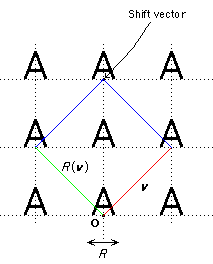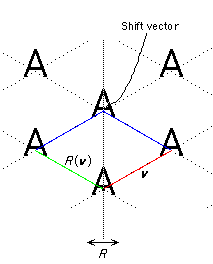Proof
(Tv ∘ A)2(x) = Tv ∘ A(v + A(x)) = Tv(A(v) + x) since A2= I and this is Tv+A(v)(x) and so v + A(v) is in the lattice.

Proof
A(a) = A(v + A(v)) = A(v) + A2(v) = A(v) + v since A2 = I and this is a again.

| Previous page (The point groups) | Contents | Next page (Classification of crystallographic groups) |
To complete the data we need for classifying the groups, we need one more concept to add to the lattice L, the point group P, and the action of P on L. This is to allow for the fact that some reflections in P act as glides rather than as reflections in G.
Definition
Let A ∈ P be a reflection with Tv ∘ A ∈ G. Then the vector a = v + A(v) is called a shift vector of A.
Properties
Proof
(Tv ∘ A)2(x) = Tv ∘ A(v + A(x)) = Tv(A(v) + x) since A2= I and this is Tv+A(v)(x) and so v + A(v) is in the lattice.

Proof
A(a) = A(v + A(v)) = A(v) + A2(v) = A(v) + v since A2 = I and this is a again.

One can in fact define a shift vector for any element of P.
For example, if R is rotation by 2π/n and Tv ∘ R ∈ G then take a = v + R(v) + R2(v) + ... + Rn-1(v). However, since a is fixed by R it must be 0 and so is not very interesting!
Examples



| Previous page (The point groups) | Contents | Next page (Classification of crystallographic groups) |